Inpatient Fall Risk: A Nursing Strategy for Minimizing Falls
VerifiedAdded on 2023/06/11
|12
|3769
|155
Essay
AI Summary
This essay provides a comprehensive analysis of fall risk in nursing, employing Walker and Avant's concept analysis method to explore its significance in inpatient care. It highlights the prevalence of falls, their associated costs, and the impact on patient well-being, including physical injuries, psychological effects, and increased mortality rates. The paper delves into the attributes of fall risk, such as the probability of accidental falls and cognitive recognition, and examines various factors contributing to falls, including medication, chronic diseases, and environmental hazards. It also discusses strategies for fall prevention, such as intentional rounding and addressing environmental risks, and emphasizes the importance of understanding fall risk factors to implement effective prevention programs. The analysis includes model cases, borderline cases, and related examples to clarify the concept and its implications for nursing practice, stressing the need for a proactive approach to minimize fall-related incidents in healthcare settings.
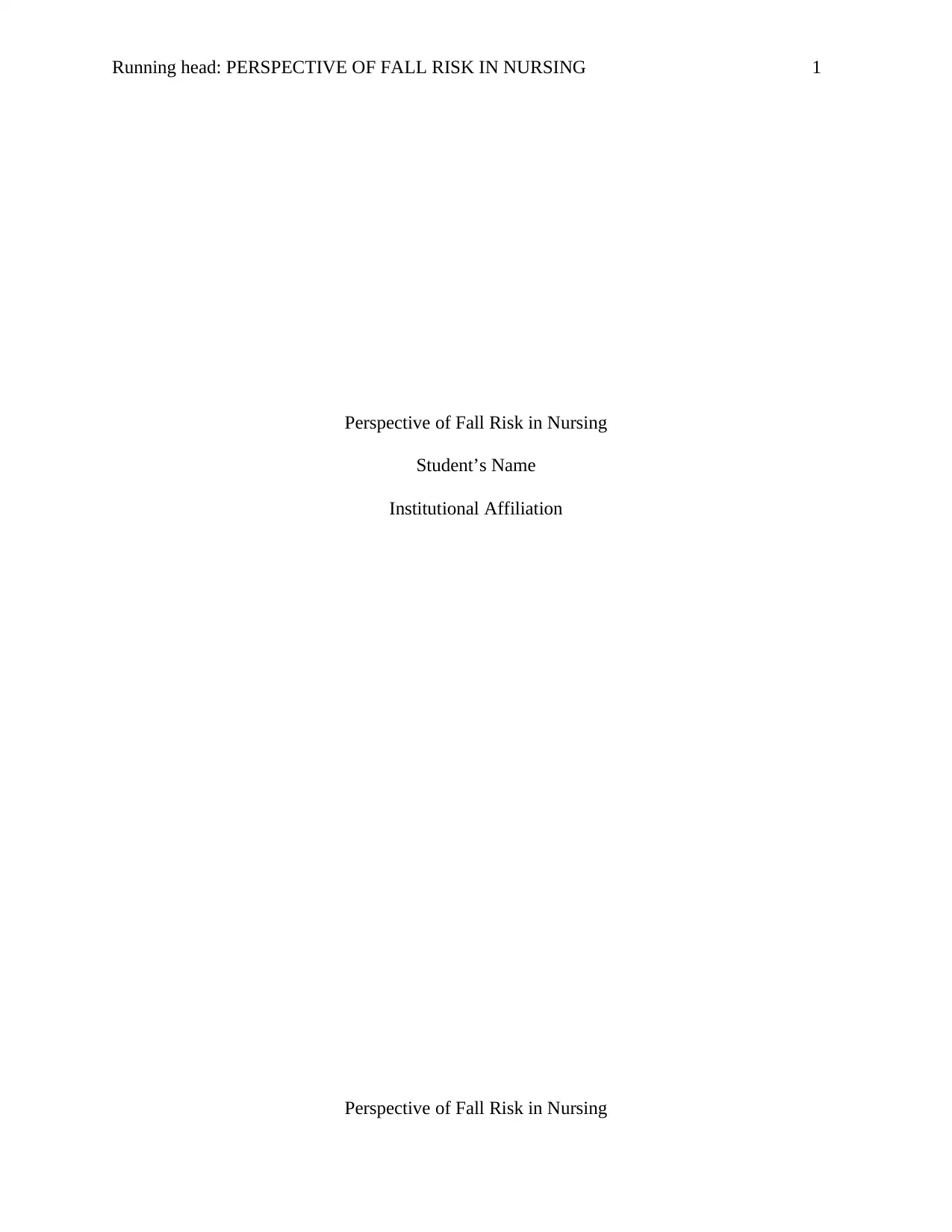
Running head: PERSPECTIVE OF FALL RISK IN NURSING 1
Perspective of Fall Risk in Nursing
Student’s Name
Institutional Affiliation
Perspective of Fall Risk in Nursing
Perspective of Fall Risk in Nursing
Student’s Name
Institutional Affiliation
Perspective of Fall Risk in Nursing
Paraphrase This Document
Need a fresh take? Get an instant paraphrase of this document with our AI Paraphraser
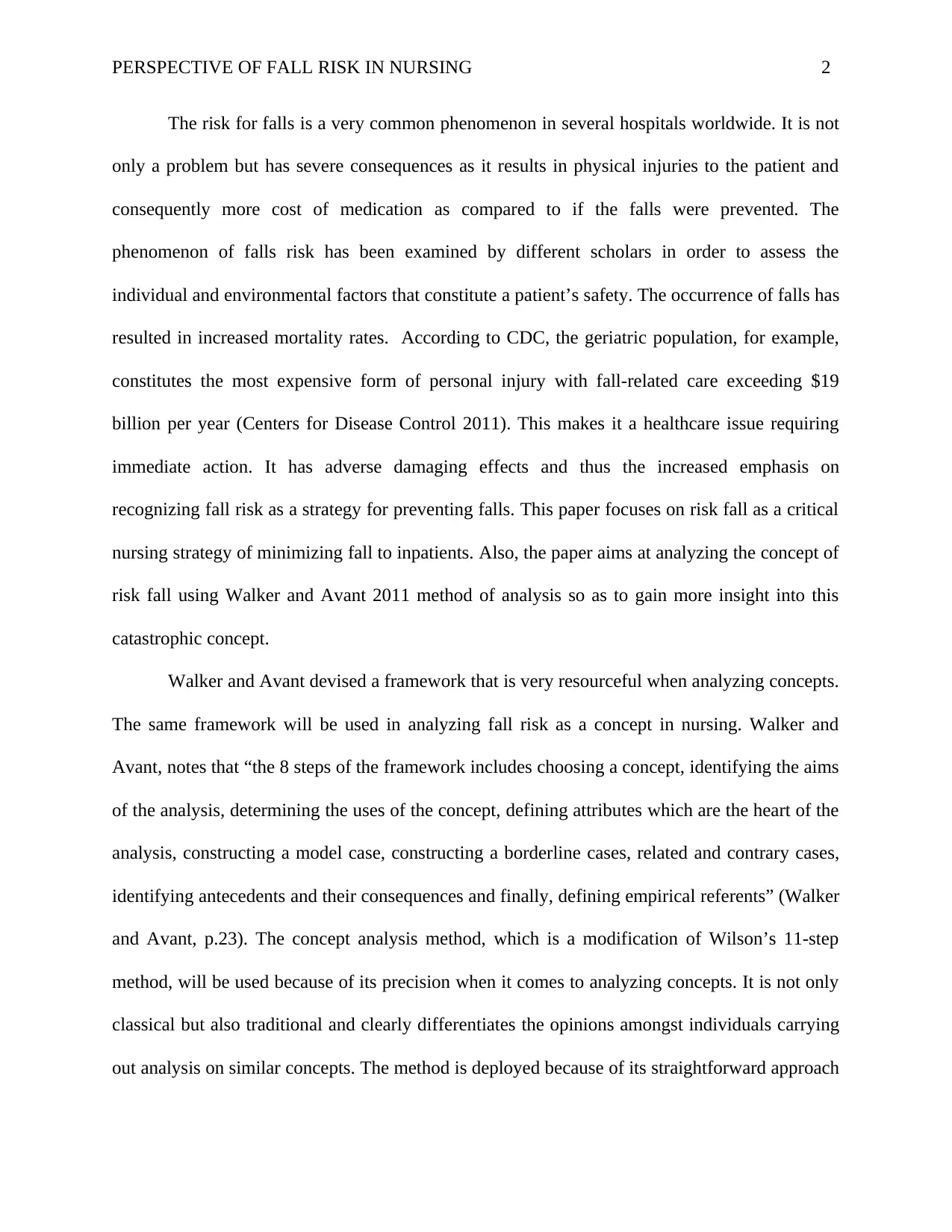
PERSPECTIVE OF FALL RISK IN NURSING 2
The risk for falls is a very common phenomenon in several hospitals worldwide. It is not
only a problem but has severe consequences as it results in physical injuries to the patient and
consequently more cost of medication as compared to if the falls were prevented. The
phenomenon of falls risk has been examined by different scholars in order to assess the
individual and environmental factors that constitute a patient’s safety. The occurrence of falls has
resulted in increased mortality rates. According to CDC, the geriatric population, for example,
constitutes the most expensive form of personal injury with fall-related care exceeding $19
billion per year (Centers for Disease Control 2011). This makes it a healthcare issue requiring
immediate action. It has adverse damaging effects and thus the increased emphasis on
recognizing fall risk as a strategy for preventing falls. This paper focuses on risk fall as a critical
nursing strategy of minimizing fall to inpatients. Also, the paper aims at analyzing the concept of
risk fall using Walker and Avant 2011 method of analysis so as to gain more insight into this
catastrophic concept.
Walker and Avant devised a framework that is very resourceful when analyzing concepts.
The same framework will be used in analyzing fall risk as a concept in nursing. Walker and
Avant, notes that “the 8 steps of the framework includes choosing a concept, identifying the aims
of the analysis, determining the uses of the concept, defining attributes which are the heart of the
analysis, constructing a model case, constructing a borderline cases, related and contrary cases,
identifying antecedents and their consequences and finally, defining empirical referents” (Walker
and Avant, p.23). The concept analysis method, which is a modification of Wilson’s 11-step
method, will be used because of its precision when it comes to analyzing concepts. It is not only
classical but also traditional and clearly differentiates the opinions amongst individuals carrying
out analysis on similar concepts. The method is deployed because of its straightforward approach
The risk for falls is a very common phenomenon in several hospitals worldwide. It is not
only a problem but has severe consequences as it results in physical injuries to the patient and
consequently more cost of medication as compared to if the falls were prevented. The
phenomenon of falls risk has been examined by different scholars in order to assess the
individual and environmental factors that constitute a patient’s safety. The occurrence of falls has
resulted in increased mortality rates. According to CDC, the geriatric population, for example,
constitutes the most expensive form of personal injury with fall-related care exceeding $19
billion per year (Centers for Disease Control 2011). This makes it a healthcare issue requiring
immediate action. It has adverse damaging effects and thus the increased emphasis on
recognizing fall risk as a strategy for preventing falls. This paper focuses on risk fall as a critical
nursing strategy of minimizing fall to inpatients. Also, the paper aims at analyzing the concept of
risk fall using Walker and Avant 2011 method of analysis so as to gain more insight into this
catastrophic concept.
Walker and Avant devised a framework that is very resourceful when analyzing concepts.
The same framework will be used in analyzing fall risk as a concept in nursing. Walker and
Avant, notes that “the 8 steps of the framework includes choosing a concept, identifying the aims
of the analysis, determining the uses of the concept, defining attributes which are the heart of the
analysis, constructing a model case, constructing a borderline cases, related and contrary cases,
identifying antecedents and their consequences and finally, defining empirical referents” (Walker
and Avant, p.23). The concept analysis method, which is a modification of Wilson’s 11-step
method, will be used because of its precision when it comes to analyzing concepts. It is not only
classical but also traditional and clearly differentiates the opinions amongst individuals carrying
out analysis on similar concepts. The method is deployed because of its straightforward approach

PERSPECTIVE OF FALL RISK IN NURSING 3
in the analysis. The approach streamlines Wilson’s methods making it more refined in analyzing
concepts.
Risk fall is the concept under analysis because of its prevalence in the healthcare units.
Little studies have been done and thus the need for more work as the probabilities of its
occurrences are still high in the hospitals. Jacob (2014) conducted a concept analysis on risk for
cancer. Additionally, several studies have been conducted on falls in a healthcare setting with
different strategies being set aside to prevent as well as reduce incidences of patient falls in these
places. These studies shed more light on the conditions on the ground and indicate why there is
the need for this concept analysis. The concept does not only affect the patients who in this case
are the victims but also has a broad effect and application to the nursing literature. Indeed, it is
the responsibility of any nurse and other medical practitioners to ensure that every patient is safe
while within the healthcare unit. With the rising rates of morbidity and mortality among culprits,
there is the need for a risk fall concept analysis. The objectives of the analysis is to help
understand the concept of risk fall by expounding on the groundwork as was conducted by Jacob.
Originally, the use of the concept risk fall was primarily applied to signify the incidence
of fall to the ground by a person. The fall could be accidental or intentional but in this respect,
the paper is concerned with accidental falls whose occurrence cannot be predicted. Later, the
term risk analysis came into play illustrating a systematic investigating and forecasting of risk in
businesses and in commerce. Different combinations have taken place since then some of them
being, risk-taking, risk factors, risk management and consequently risk fall. Apart from the
traditional use of the concept, the term risk fall is found appropriate in literature. Review of the
different philosophy, nursing, ethics, sociology, education, and economics found a wide use of
this concept though it is rarely defined in the different disciplines (Degelau et al., 2012).
in the analysis. The approach streamlines Wilson’s methods making it more refined in analyzing
concepts.
Risk fall is the concept under analysis because of its prevalence in the healthcare units.
Little studies have been done and thus the need for more work as the probabilities of its
occurrences are still high in the hospitals. Jacob (2014) conducted a concept analysis on risk for
cancer. Additionally, several studies have been conducted on falls in a healthcare setting with
different strategies being set aside to prevent as well as reduce incidences of patient falls in these
places. These studies shed more light on the conditions on the ground and indicate why there is
the need for this concept analysis. The concept does not only affect the patients who in this case
are the victims but also has a broad effect and application to the nursing literature. Indeed, it is
the responsibility of any nurse and other medical practitioners to ensure that every patient is safe
while within the healthcare unit. With the rising rates of morbidity and mortality among culprits,
there is the need for a risk fall concept analysis. The objectives of the analysis is to help
understand the concept of risk fall by expounding on the groundwork as was conducted by Jacob.
Originally, the use of the concept risk fall was primarily applied to signify the incidence
of fall to the ground by a person. The fall could be accidental or intentional but in this respect,
the paper is concerned with accidental falls whose occurrence cannot be predicted. Later, the
term risk analysis came into play illustrating a systematic investigating and forecasting of risk in
businesses and in commerce. Different combinations have taken place since then some of them
being, risk-taking, risk factors, risk management and consequently risk fall. Apart from the
traditional use of the concept, the term risk fall is found appropriate in literature. Review of the
different philosophy, nursing, ethics, sociology, education, and economics found a wide use of
this concept though it is rarely defined in the different disciplines (Degelau et al., 2012).
⊘ This is a preview!⊘
Do you want full access?
Subscribe today to unlock all pages.

Trusted by 1+ million students worldwide

PERSPECTIVE OF FALL RISK IN NURSING 4
According to nursing diagnosis association, the risk of falls is a categorized as a nursing
diagnosis which increases susceptibility to fall and may result in physical harm. As the word
suggests, risk is the possibility or the likelihood that a certain loss or danger will occur while a
fall, on the other hand, is an accidental or sometimes intentional occurrence in which the patient
inadvertently comes to a rest on the ground. In nursing, falls are considered accidental or
unexpected and as such, there is a high potential for injuries (Harvey et al., 2010). The concept is
however not limited to the medical field but spreads over the different fields.
In the year 2010, the emergency department treated approximately 2.3 million citizens
from incidents of fall and a quarter of these population was hospitalized. Inpatient fall prevention
has been an individual area of concern in the last 50 years but when it comes to patients in the
healthcare units’, nurses have the sole responsibility of ensuring that the patients are safe and
free from falls. In the past, incident reports in the hospitals deemed falls as avoidable and for that
reason, were considered as adverse occurrences (Titler et al., 2011). Underreporting is likely to
happen and particularly in no injury is associated with the fall.
To comfortably manage falls, there is the need to identify residents or patients who are
most vulnerable to falls. Intentional rounding has proved to reduce falls by 60% in most hospitals
and inpatient settings. During this rounding practice, nurses and other hospital staff address the
concerns of their patients and this could be through repositioning, toileting and making patients
related goodies more accessible so as to prevent any risk of fall while trying to retrieve the items.
These items may include, phones, magazines etc.
Consistently, the literature shows the fall fatality rate is at 36.8 out of a 100,000
Americans at the age 65 years and above. Most of these falls are associated with minor soft
tissue injuries for example bruises and scrapes. Only about 10-15% of them result in fractures
According to nursing diagnosis association, the risk of falls is a categorized as a nursing
diagnosis which increases susceptibility to fall and may result in physical harm. As the word
suggests, risk is the possibility or the likelihood that a certain loss or danger will occur while a
fall, on the other hand, is an accidental or sometimes intentional occurrence in which the patient
inadvertently comes to a rest on the ground. In nursing, falls are considered accidental or
unexpected and as such, there is a high potential for injuries (Harvey et al., 2010). The concept is
however not limited to the medical field but spreads over the different fields.
In the year 2010, the emergency department treated approximately 2.3 million citizens
from incidents of fall and a quarter of these population was hospitalized. Inpatient fall prevention
has been an individual area of concern in the last 50 years but when it comes to patients in the
healthcare units’, nurses have the sole responsibility of ensuring that the patients are safe and
free from falls. In the past, incident reports in the hospitals deemed falls as avoidable and for that
reason, were considered as adverse occurrences (Titler et al., 2011). Underreporting is likely to
happen and particularly in no injury is associated with the fall.
To comfortably manage falls, there is the need to identify residents or patients who are
most vulnerable to falls. Intentional rounding has proved to reduce falls by 60% in most hospitals
and inpatient settings. During this rounding practice, nurses and other hospital staff address the
concerns of their patients and this could be through repositioning, toileting and making patients
related goodies more accessible so as to prevent any risk of fall while trying to retrieve the items.
These items may include, phones, magazines etc.
Consistently, the literature shows the fall fatality rate is at 36.8 out of a 100,000
Americans at the age 65 years and above. Most of these falls are associated with minor soft
tissue injuries for example bruises and scrapes. Only about 10-15% of them result in fractures
Paraphrase This Document
Need a fresh take? Get an instant paraphrase of this document with our AI Paraphraser

PERSPECTIVE OF FALL RISK IN NURSING 5
among other serious injuries which are likely to result in morbidity and mortality to the patients.
Falls occur more frequently in the elderly than in the young population. Falls are therefore more
prevalent in nursing homes and constitutes about 40% of all nursing homes admissions (Quigley,
Barnett, Bulat and Friedman 2016). Studies show that it costs the elderly persons about $4200 to
$5400 per month of skilled care from their nursing homes upon sustenance to fall injuries. To
make the matters worse, this cost does not include co-insurance cost and transportation charges
to and from the specialists.
As regards to quality of life, patients do suffer from physical health as well as their
psychosocial well-being. Most patient and particularly culprits of fall develop the fear of falling
and consequently lose self-confidence when it comes to standing or moving about. This fear
results in a cascade of further problems which includes loss of independence, depression, social
isolations and dementia exacerbation. Cognitively impaired patients are likely to experience yet
another fall after the first one due to the inability to communicate their fear. Also, the risk of fall
has been associated with an increase in patient’s anxiety increasing the risk of fall even when the
possibilities are very minimal (Preshaw, Brazil, McLaughlin and Frolic 2016).
It is clear that falls affect the family at large. The family member needs to seek extended
medical care for their patients and particularly those who have lost their morbidity. The culprits
develop a feeling of denial, hatred, anger, and depression. The causes of fall are multifactorial.
Apart from personal reasons, medication background can result in weaknesses and confusion to a
patient. This mix raises the risks for fall to the said patients (Ireland, Kirkpatrick, Boblin and
Robertson 2013). Additionally, some chronic and acute diseases, muscle weaknesses and gait
problems can as well raise the risk fall. Of importance in this paper is the environmental hazards
in the nursing home which accounts for 16-27 % of all incidences. These factors include facility
among other serious injuries which are likely to result in morbidity and mortality to the patients.
Falls occur more frequently in the elderly than in the young population. Falls are therefore more
prevalent in nursing homes and constitutes about 40% of all nursing homes admissions (Quigley,
Barnett, Bulat and Friedman 2016). Studies show that it costs the elderly persons about $4200 to
$5400 per month of skilled care from their nursing homes upon sustenance to fall injuries. To
make the matters worse, this cost does not include co-insurance cost and transportation charges
to and from the specialists.
As regards to quality of life, patients do suffer from physical health as well as their
psychosocial well-being. Most patient and particularly culprits of fall develop the fear of falling
and consequently lose self-confidence when it comes to standing or moving about. This fear
results in a cascade of further problems which includes loss of independence, depression, social
isolations and dementia exacerbation. Cognitively impaired patients are likely to experience yet
another fall after the first one due to the inability to communicate their fear. Also, the risk of fall
has been associated with an increase in patient’s anxiety increasing the risk of fall even when the
possibilities are very minimal (Preshaw, Brazil, McLaughlin and Frolic 2016).
It is clear that falls affect the family at large. The family member needs to seek extended
medical care for their patients and particularly those who have lost their morbidity. The culprits
develop a feeling of denial, hatred, anger, and depression. The causes of fall are multifactorial.
Apart from personal reasons, medication background can result in weaknesses and confusion to a
patient. This mix raises the risks for fall to the said patients (Ireland, Kirkpatrick, Boblin and
Robertson 2013). Additionally, some chronic and acute diseases, muscle weaknesses and gait
problems can as well raise the risk fall. Of importance in this paper is the environmental hazards
in the nursing home which accounts for 16-27 % of all incidences. These factors include facility

PERSPECTIVE OF FALL RISK IN NURSING 6
flooring, placement of furniture, tipping over foot pedal of a wheelchair, bed lights, bed height
and staff movement factors that are likely to cause a fall to the facility residents. Carpeted floor
significantly raise the risk of falling as compared to vinyl flooring. Other factors such as
malfunctioning alarms, clustering, unfamiliar environment and unanswered call lights have
proven to pose a risk of falling to residents/patients (Fonad 2008).
As far as fall is concerned, patients suffering from more than one illness eventually
require more than one drug. The side effects of these drugs are poses a risk of falling to the
patient, particularly due to the lack of cognition or alertness. Some medicines such as
psychotropic drugs sometimes affect the minds, behavior, and emotions of a patient and
consequently being a threat to the consumers’ safety. Also, in several instances, patients show a
high tendency of falling two to three days after the change of medication. This is most evident if
those medications affect the nervous system. From this discussion, it is clear that there is the
need to determine the fall–risk-factors both in hospitals and other healthcare units so as to be in a
position to completely address these factors and therefore reduce to a bare minimum the risks
associated with the event of fall. It is from this understanding that appropriate programs and
frameworks have been put in place to addresses falls risk (Graham 2012). Several of such
programs have been devised and are up for practice by the nurses and other medical personnel.
As regards to attributes, these are the characteristics of risk fall that tend to appear again
and again. Based on available literature, the important attributes behind this concept include the
probability of accidental fall on the ground by the patients and the cognitive recognition of the
thoughts and overall perception of the victim towards his own self or towards others.
A model case is an illustration of a real-life situation which incorporates the critical attributes of
a concept (Weber and Kelley 2010). Consider a home health nurse in her very initial visits to a
flooring, placement of furniture, tipping over foot pedal of a wheelchair, bed lights, bed height
and staff movement factors that are likely to cause a fall to the facility residents. Carpeted floor
significantly raise the risk of falling as compared to vinyl flooring. Other factors such as
malfunctioning alarms, clustering, unfamiliar environment and unanswered call lights have
proven to pose a risk of falling to residents/patients (Fonad 2008).
As far as fall is concerned, patients suffering from more than one illness eventually
require more than one drug. The side effects of these drugs are poses a risk of falling to the
patient, particularly due to the lack of cognition or alertness. Some medicines such as
psychotropic drugs sometimes affect the minds, behavior, and emotions of a patient and
consequently being a threat to the consumers’ safety. Also, in several instances, patients show a
high tendency of falling two to three days after the change of medication. This is most evident if
those medications affect the nervous system. From this discussion, it is clear that there is the
need to determine the fall–risk-factors both in hospitals and other healthcare units so as to be in a
position to completely address these factors and therefore reduce to a bare minimum the risks
associated with the event of fall. It is from this understanding that appropriate programs and
frameworks have been put in place to addresses falls risk (Graham 2012). Several of such
programs have been devised and are up for practice by the nurses and other medical personnel.
As regards to attributes, these are the characteristics of risk fall that tend to appear again
and again. Based on available literature, the important attributes behind this concept include the
probability of accidental fall on the ground by the patients and the cognitive recognition of the
thoughts and overall perception of the victim towards his own self or towards others.
A model case is an illustration of a real-life situation which incorporates the critical attributes of
a concept (Weber and Kelley 2010). Consider a home health nurse in her very initial visits to a
⊘ This is a preview!⊘
Do you want full access?
Subscribe today to unlock all pages.

Trusted by 1+ million students worldwide
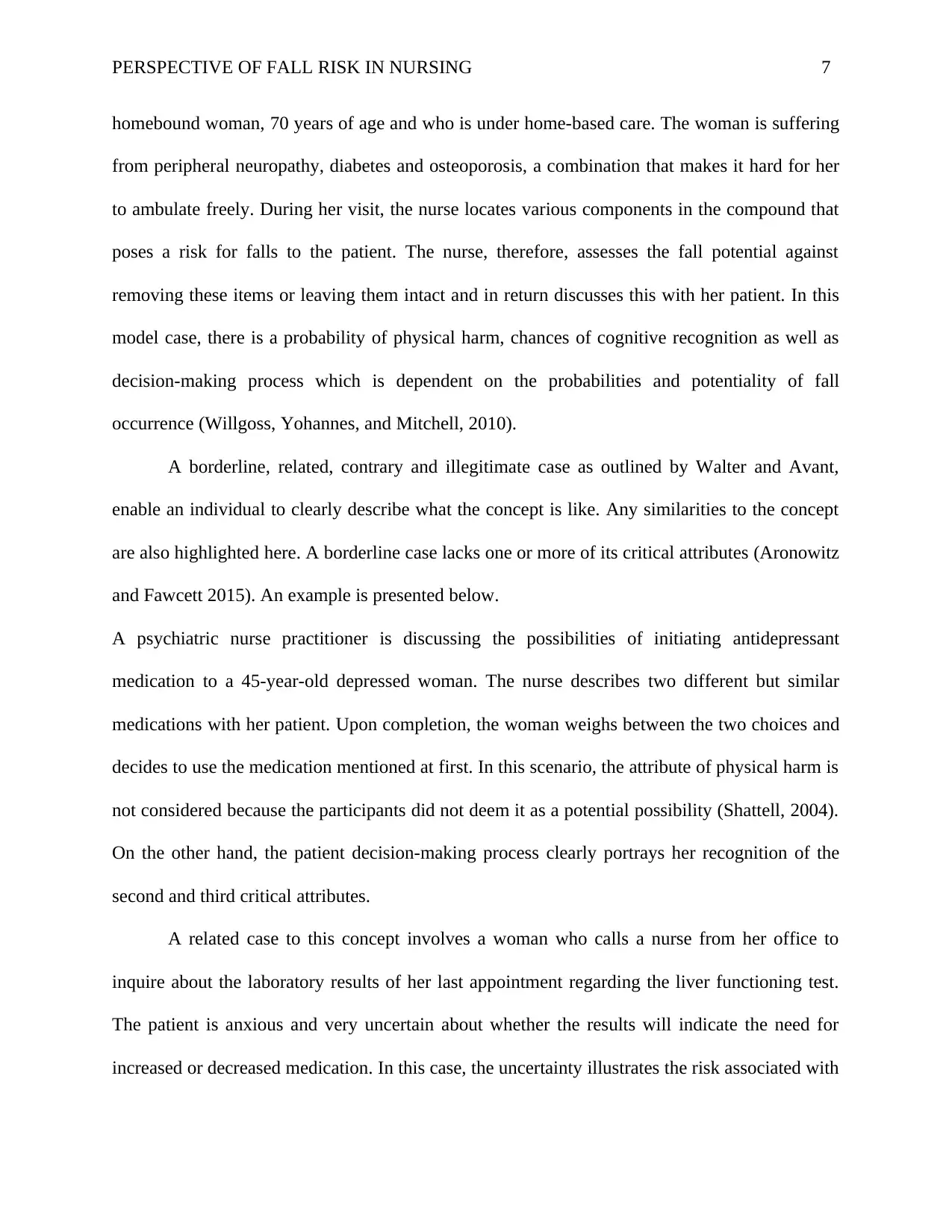
PERSPECTIVE OF FALL RISK IN NURSING 7
homebound woman, 70 years of age and who is under home-based care. The woman is suffering
from peripheral neuropathy, diabetes and osteoporosis, a combination that makes it hard for her
to ambulate freely. During her visit, the nurse locates various components in the compound that
poses a risk for falls to the patient. The nurse, therefore, assesses the fall potential against
removing these items or leaving them intact and in return discusses this with her patient. In this
model case, there is a probability of physical harm, chances of cognitive recognition as well as
decision-making process which is dependent on the probabilities and potentiality of fall
occurrence (Willgoss, Yohannes, and Mitchell, 2010).
A borderline, related, contrary and illegitimate case as outlined by Walter and Avant,
enable an individual to clearly describe what the concept is like. Any similarities to the concept
are also highlighted here. A borderline case lacks one or more of its critical attributes (Aronowitz
and Fawcett 2015). An example is presented below.
A psychiatric nurse practitioner is discussing the possibilities of initiating antidepressant
medication to a 45-year-old depressed woman. The nurse describes two different but similar
medications with her patient. Upon completion, the woman weighs between the two choices and
decides to use the medication mentioned at first. In this scenario, the attribute of physical harm is
not considered because the participants did not deem it as a potential possibility (Shattell, 2004).
On the other hand, the patient decision-making process clearly portrays her recognition of the
second and third critical attributes.
A related case to this concept involves a woman who calls a nurse from her office to
inquire about the laboratory results of her last appointment regarding the liver functioning test.
The patient is anxious and very uncertain about whether the results will indicate the need for
increased or decreased medication. In this case, the uncertainty illustrates the risk associated with
homebound woman, 70 years of age and who is under home-based care. The woman is suffering
from peripheral neuropathy, diabetes and osteoporosis, a combination that makes it hard for her
to ambulate freely. During her visit, the nurse locates various components in the compound that
poses a risk for falls to the patient. The nurse, therefore, assesses the fall potential against
removing these items or leaving them intact and in return discusses this with her patient. In this
model case, there is a probability of physical harm, chances of cognitive recognition as well as
decision-making process which is dependent on the probabilities and potentiality of fall
occurrence (Willgoss, Yohannes, and Mitchell, 2010).
A borderline, related, contrary and illegitimate case as outlined by Walter and Avant,
enable an individual to clearly describe what the concept is like. Any similarities to the concept
are also highlighted here. A borderline case lacks one or more of its critical attributes (Aronowitz
and Fawcett 2015). An example is presented below.
A psychiatric nurse practitioner is discussing the possibilities of initiating antidepressant
medication to a 45-year-old depressed woman. The nurse describes two different but similar
medications with her patient. Upon completion, the woman weighs between the two choices and
decides to use the medication mentioned at first. In this scenario, the attribute of physical harm is
not considered because the participants did not deem it as a potential possibility (Shattell, 2004).
On the other hand, the patient decision-making process clearly portrays her recognition of the
second and third critical attributes.
A related case to this concept involves a woman who calls a nurse from her office to
inquire about the laboratory results of her last appointment regarding the liver functioning test.
The patient is anxious and very uncertain about whether the results will indicate the need for
increased or decreased medication. In this case, the uncertainty illustrates the risk associated with
Paraphrase This Document
Need a fresh take? Get an instant paraphrase of this document with our AI Paraphraser
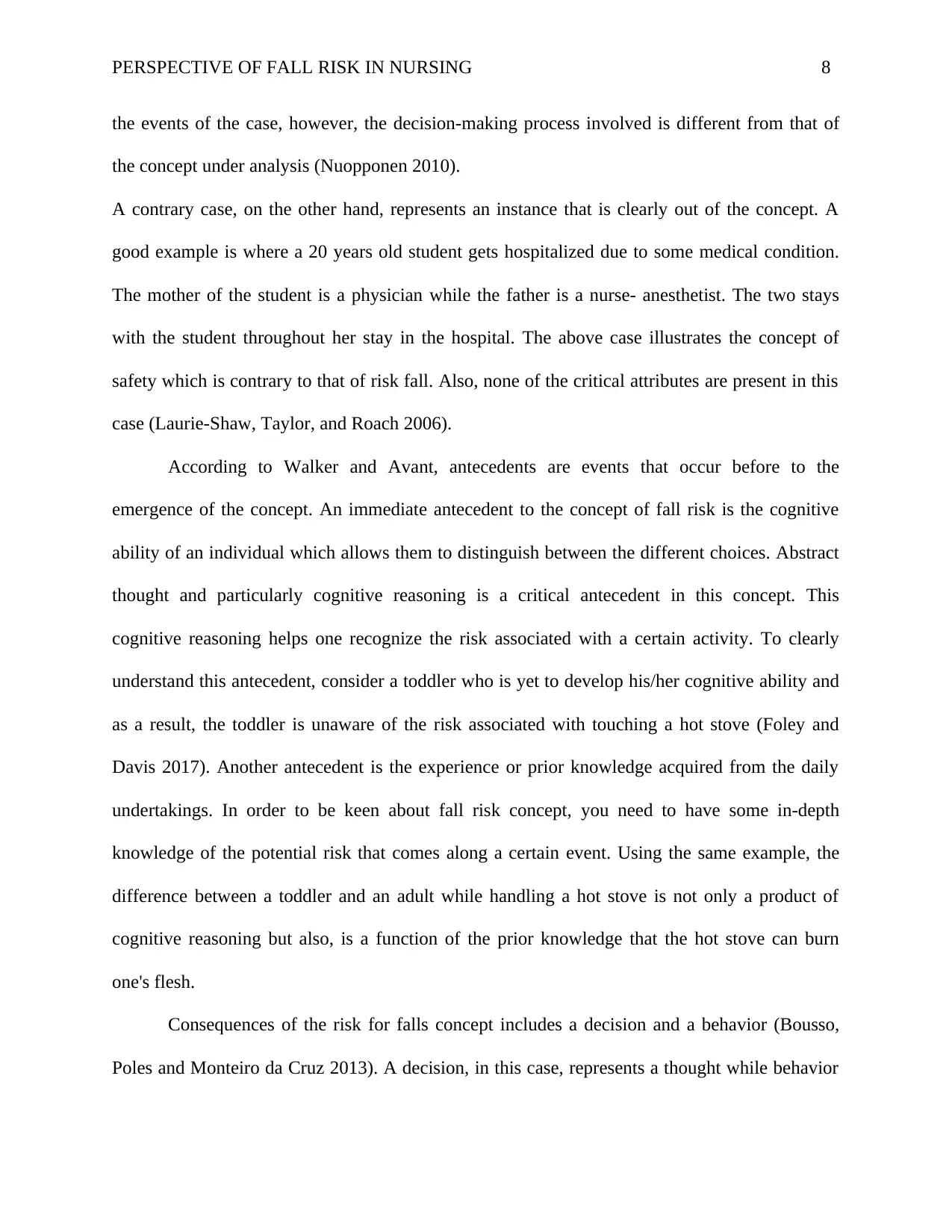
PERSPECTIVE OF FALL RISK IN NURSING 8
the events of the case, however, the decision-making process involved is different from that of
the concept under analysis (Nuopponen 2010).
A contrary case, on the other hand, represents an instance that is clearly out of the concept. A
good example is where a 20 years old student gets hospitalized due to some medical condition.
The mother of the student is a physician while the father is a nurse- anesthetist. The two stays
with the student throughout her stay in the hospital. The above case illustrates the concept of
safety which is contrary to that of risk fall. Also, none of the critical attributes are present in this
case (Laurie-Shaw, Taylor, and Roach 2006).
According to Walker and Avant, antecedents are events that occur before to the
emergence of the concept. An immediate antecedent to the concept of fall risk is the cognitive
ability of an individual which allows them to distinguish between the different choices. Abstract
thought and particularly cognitive reasoning is a critical antecedent in this concept. This
cognitive reasoning helps one recognize the risk associated with a certain activity. To clearly
understand this antecedent, consider a toddler who is yet to develop his/her cognitive ability and
as a result, the toddler is unaware of the risk associated with touching a hot stove (Foley and
Davis 2017). Another antecedent is the experience or prior knowledge acquired from the daily
undertakings. In order to be keen about fall risk concept, you need to have some in-depth
knowledge of the potential risk that comes along a certain event. Using the same example, the
difference between a toddler and an adult while handling a hot stove is not only a product of
cognitive reasoning but also, is a function of the prior knowledge that the hot stove can burn
one's flesh.
Consequences of the risk for falls concept includes a decision and a behavior (Bousso,
Poles and Monteiro da Cruz 2013). A decision, in this case, represents a thought while behavior
the events of the case, however, the decision-making process involved is different from that of
the concept under analysis (Nuopponen 2010).
A contrary case, on the other hand, represents an instance that is clearly out of the concept. A
good example is where a 20 years old student gets hospitalized due to some medical condition.
The mother of the student is a physician while the father is a nurse- anesthetist. The two stays
with the student throughout her stay in the hospital. The above case illustrates the concept of
safety which is contrary to that of risk fall. Also, none of the critical attributes are present in this
case (Laurie-Shaw, Taylor, and Roach 2006).
According to Walker and Avant, antecedents are events that occur before to the
emergence of the concept. An immediate antecedent to the concept of fall risk is the cognitive
ability of an individual which allows them to distinguish between the different choices. Abstract
thought and particularly cognitive reasoning is a critical antecedent in this concept. This
cognitive reasoning helps one recognize the risk associated with a certain activity. To clearly
understand this antecedent, consider a toddler who is yet to develop his/her cognitive ability and
as a result, the toddler is unaware of the risk associated with touching a hot stove (Foley and
Davis 2017). Another antecedent is the experience or prior knowledge acquired from the daily
undertakings. In order to be keen about fall risk concept, you need to have some in-depth
knowledge of the potential risk that comes along a certain event. Using the same example, the
difference between a toddler and an adult while handling a hot stove is not only a product of
cognitive reasoning but also, is a function of the prior knowledge that the hot stove can burn
one's flesh.
Consequences of the risk for falls concept includes a decision and a behavior (Bousso,
Poles and Monteiro da Cruz 2013). A decision, in this case, represents a thought while behavior
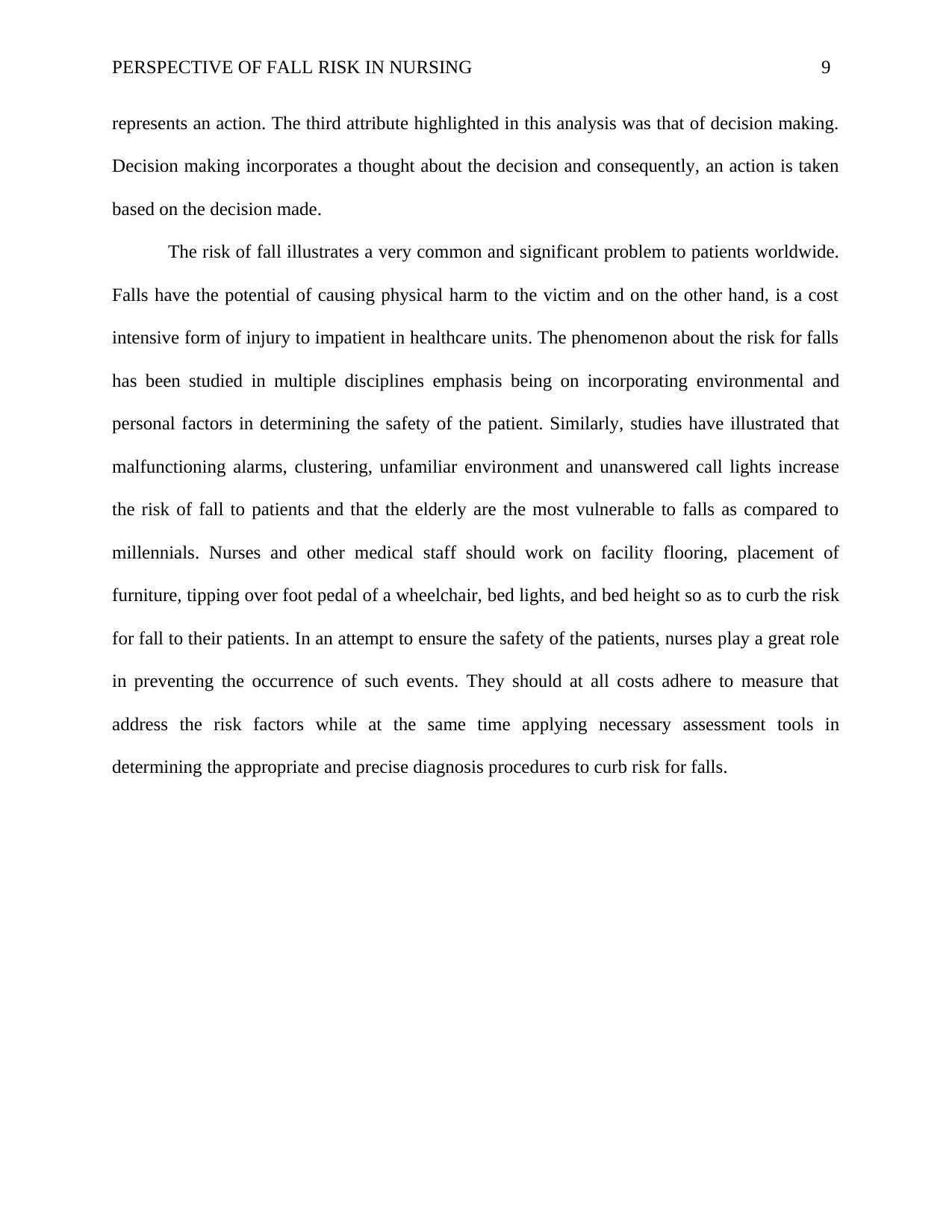
PERSPECTIVE OF FALL RISK IN NURSING 9
represents an action. The third attribute highlighted in this analysis was that of decision making.
Decision making incorporates a thought about the decision and consequently, an action is taken
based on the decision made.
The risk of fall illustrates a very common and significant problem to patients worldwide.
Falls have the potential of causing physical harm to the victim and on the other hand, is a cost
intensive form of injury to impatient in healthcare units. The phenomenon about the risk for falls
has been studied in multiple disciplines emphasis being on incorporating environmental and
personal factors in determining the safety of the patient. Similarly, studies have illustrated that
malfunctioning alarms, clustering, unfamiliar environment and unanswered call lights increase
the risk of fall to patients and that the elderly are the most vulnerable to falls as compared to
millennials. Nurses and other medical staff should work on facility flooring, placement of
furniture, tipping over foot pedal of a wheelchair, bed lights, and bed height so as to curb the risk
for fall to their patients. In an attempt to ensure the safety of the patients, nurses play a great role
in preventing the occurrence of such events. They should at all costs adhere to measure that
address the risk factors while at the same time applying necessary assessment tools in
determining the appropriate and precise diagnosis procedures to curb risk for falls.
represents an action. The third attribute highlighted in this analysis was that of decision making.
Decision making incorporates a thought about the decision and consequently, an action is taken
based on the decision made.
The risk of fall illustrates a very common and significant problem to patients worldwide.
Falls have the potential of causing physical harm to the victim and on the other hand, is a cost
intensive form of injury to impatient in healthcare units. The phenomenon about the risk for falls
has been studied in multiple disciplines emphasis being on incorporating environmental and
personal factors in determining the safety of the patient. Similarly, studies have illustrated that
malfunctioning alarms, clustering, unfamiliar environment and unanswered call lights increase
the risk of fall to patients and that the elderly are the most vulnerable to falls as compared to
millennials. Nurses and other medical staff should work on facility flooring, placement of
furniture, tipping over foot pedal of a wheelchair, bed lights, and bed height so as to curb the risk
for fall to their patients. In an attempt to ensure the safety of the patients, nurses play a great role
in preventing the occurrence of such events. They should at all costs adhere to measure that
address the risk factors while at the same time applying necessary assessment tools in
determining the appropriate and precise diagnosis procedures to curb risk for falls.
⊘ This is a preview!⊘
Do you want full access?
Subscribe today to unlock all pages.

Trusted by 1+ million students worldwide
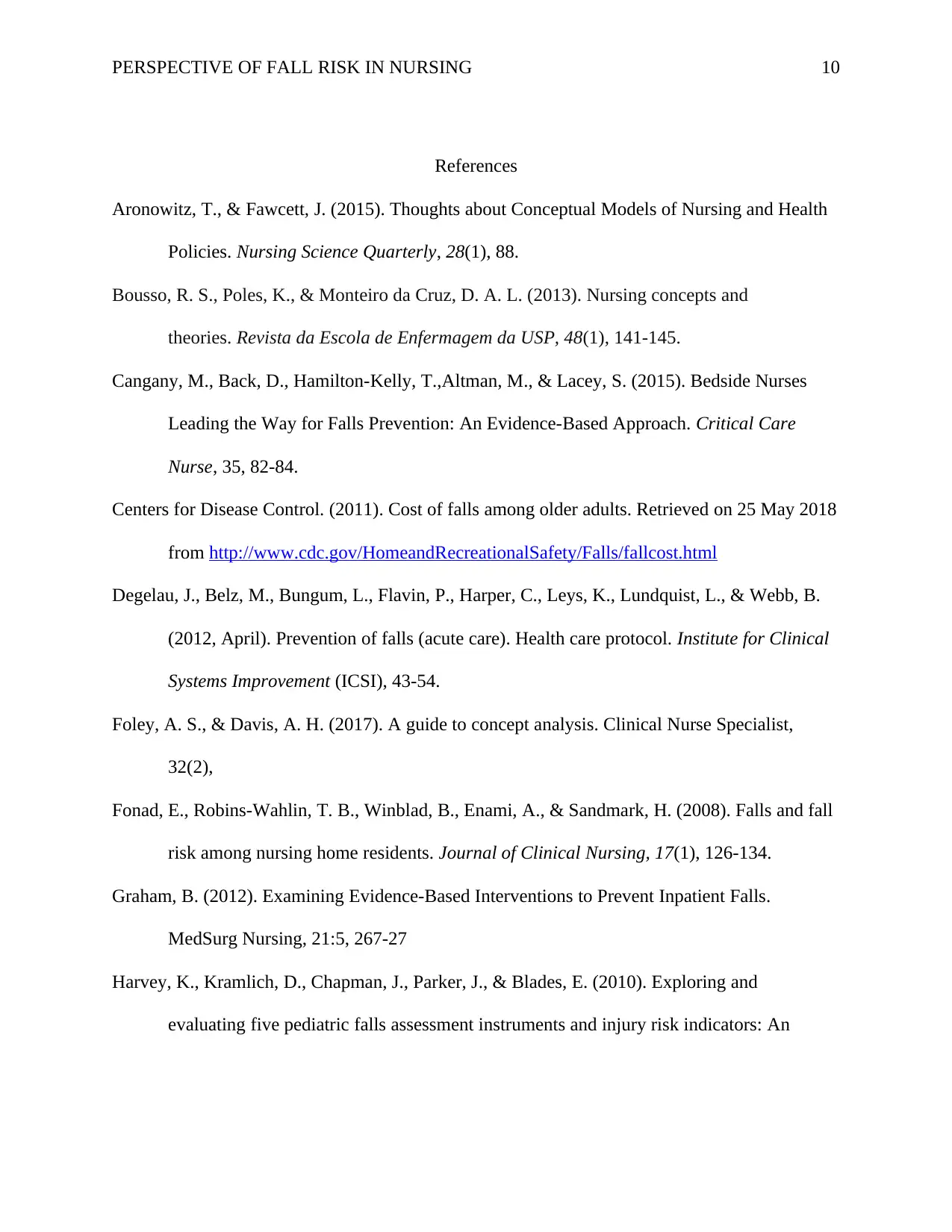
PERSPECTIVE OF FALL RISK IN NURSING 10
References
Aronowitz, T., & Fawcett, J. (2015). Thoughts about Conceptual Models of Nursing and Health
Policies. Nursing Science Quarterly, 28(1), 88.
Bousso, R. S., Poles, K., & Monteiro da Cruz, D. A. L. (2013). Nursing concepts and
theories. Revista da Escola de Enfermagem da USP, 48(1), 141-145.
Cangany, M., Back, D., Hamilton-Kelly, T.,Altman, M., & Lacey, S. (2015). Bedside Nurses
Leading the Way for Falls Prevention: An Evidence-Based Approach. Critical Care
Nurse, 35, 82-84.
Centers for Disease Control. (2011). Cost of falls among older adults. Retrieved on 25 May 2018
from http://www.cdc.gov/HomeandRecreationalSafety/Falls/fallcost.html
Degelau, J., Belz, M., Bungum, L., Flavin, P., Harper, C., Leys, K., Lundquist, L., & Webb, B.
(2012, April). Prevention of falls (acute care). Health care protocol. Institute for Clinical
Systems Improvement (ICSI), 43-54.
Foley, A. S., & Davis, A. H. (2017). A guide to concept analysis. Clinical Nurse Specialist,
32(2),
Fonad, E., Robins-Wahlin, T. B., Winblad, B., Enami, A., & Sandmark, H. (2008). Falls and fall
risk among nursing home residents. Journal of Clinical Nursing, 17(1), 126-134.
Graham, B. (2012). Examining Evidence-Based Interventions to Prevent Inpatient Falls.
MedSurg Nursing, 21:5, 267-27
Harvey, K., Kramlich, D., Chapman, J., Parker, J., & Blades, E. (2010). Exploring and
evaluating five pediatric falls assessment instruments and injury risk indicators: An
References
Aronowitz, T., & Fawcett, J. (2015). Thoughts about Conceptual Models of Nursing and Health
Policies. Nursing Science Quarterly, 28(1), 88.
Bousso, R. S., Poles, K., & Monteiro da Cruz, D. A. L. (2013). Nursing concepts and
theories. Revista da Escola de Enfermagem da USP, 48(1), 141-145.
Cangany, M., Back, D., Hamilton-Kelly, T.,Altman, M., & Lacey, S. (2015). Bedside Nurses
Leading the Way for Falls Prevention: An Evidence-Based Approach. Critical Care
Nurse, 35, 82-84.
Centers for Disease Control. (2011). Cost of falls among older adults. Retrieved on 25 May 2018
from http://www.cdc.gov/HomeandRecreationalSafety/Falls/fallcost.html
Degelau, J., Belz, M., Bungum, L., Flavin, P., Harper, C., Leys, K., Lundquist, L., & Webb, B.
(2012, April). Prevention of falls (acute care). Health care protocol. Institute for Clinical
Systems Improvement (ICSI), 43-54.
Foley, A. S., & Davis, A. H. (2017). A guide to concept analysis. Clinical Nurse Specialist,
32(2),
Fonad, E., Robins-Wahlin, T. B., Winblad, B., Enami, A., & Sandmark, H. (2008). Falls and fall
risk among nursing home residents. Journal of Clinical Nursing, 17(1), 126-134.
Graham, B. (2012). Examining Evidence-Based Interventions to Prevent Inpatient Falls.
MedSurg Nursing, 21:5, 267-27
Harvey, K., Kramlich, D., Chapman, J., Parker, J., & Blades, E. (2010). Exploring and
evaluating five pediatric falls assessment instruments and injury risk indicators: An
Paraphrase This Document
Need a fresh take? Get an instant paraphrase of this document with our AI Paraphraser
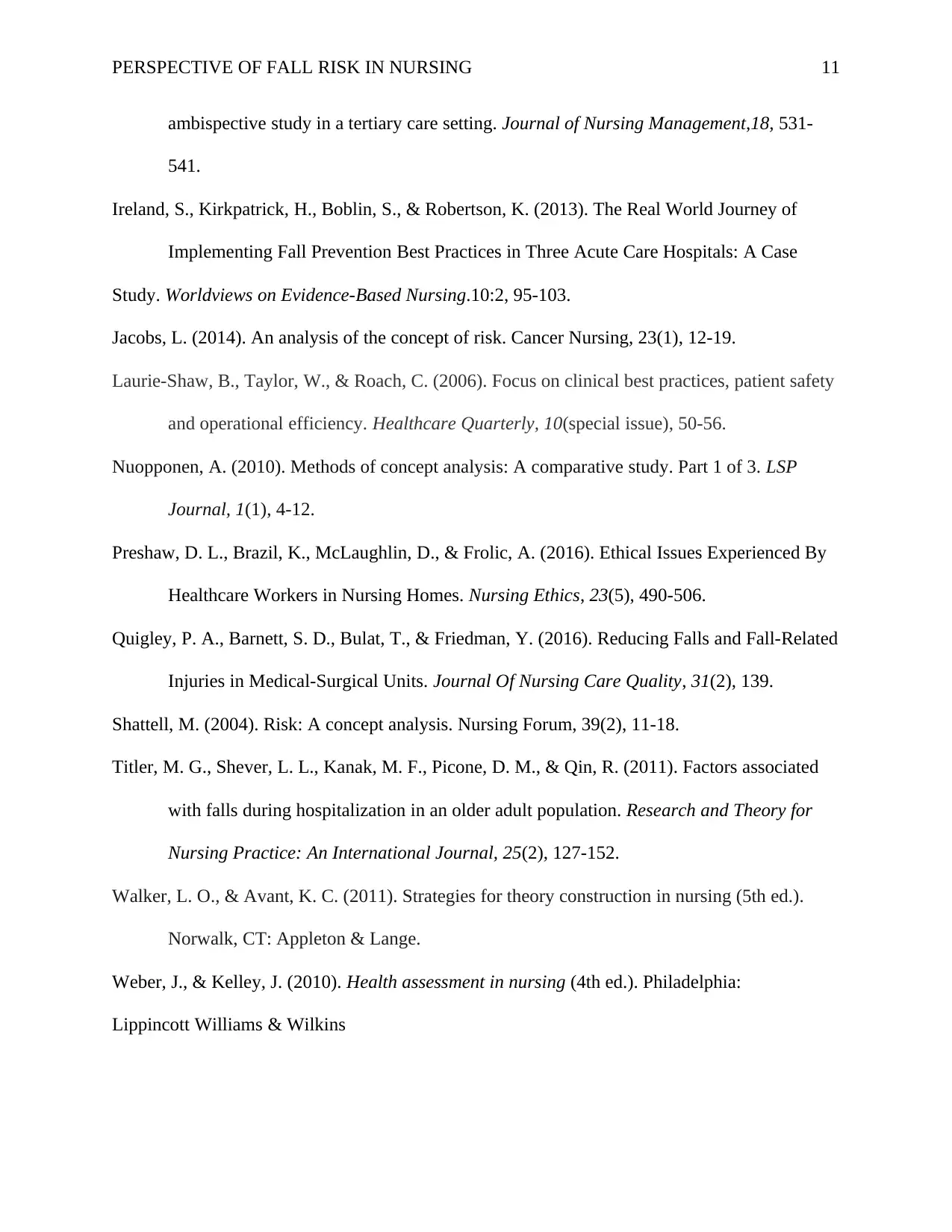
PERSPECTIVE OF FALL RISK IN NURSING 11
ambispective study in a tertiary care setting. Journal of Nursing Management,18, 531-
541.
Ireland, S., Kirkpatrick, H., Boblin, S., & Robertson, K. (2013). The Real World Journey of
Implementing Fall Prevention Best Practices in Three Acute Care Hospitals: A Case
Study. Worldviews on Evidence-Based Nursing.10:2, 95-103.
Jacobs, L. (2014). An analysis of the concept of risk. Cancer Nursing, 23(1), 12-19.
Laurie-Shaw, B., Taylor, W., & Roach, C. (2006). Focus on clinical best practices, patient safety
and operational efficiency. Healthcare Quarterly, 10(special issue), 50-56.
Nuopponen, A. (2010). Methods of concept analysis: A comparative study. Part 1 of 3. LSP
Journal, 1(1), 4-12.
Preshaw, D. L., Brazil, K., McLaughlin, D., & Frolic, A. (2016). Ethical Issues Experienced By
Healthcare Workers in Nursing Homes. Nursing Ethics, 23(5), 490-506.
Quigley, P. A., Barnett, S. D., Bulat, T., & Friedman, Y. (2016). Reducing Falls and Fall-Related
Injuries in Medical-Surgical Units. Journal Of Nursing Care Quality, 31(2), 139.
Shattell, M. (2004). Risk: A concept analysis. Nursing Forum, 39(2), 11-18.
Titler, M. G., Shever, L. L., Kanak, M. F., Picone, D. M., & Qin, R. (2011). Factors associated
with falls during hospitalization in an older adult population. Research and Theory for
Nursing Practice: An International Journal, 25(2), 127-152.
Walker, L. O., & Avant, K. C. (2011). Strategies for theory construction in nursing (5th ed.).
Norwalk, CT: Appleton & Lange.
Weber, J., & Kelley, J. (2010). Health assessment in nursing (4th ed.). Philadelphia:
Lippincott Williams & Wilkins
ambispective study in a tertiary care setting. Journal of Nursing Management,18, 531-
541.
Ireland, S., Kirkpatrick, H., Boblin, S., & Robertson, K. (2013). The Real World Journey of
Implementing Fall Prevention Best Practices in Three Acute Care Hospitals: A Case
Study. Worldviews on Evidence-Based Nursing.10:2, 95-103.
Jacobs, L. (2014). An analysis of the concept of risk. Cancer Nursing, 23(1), 12-19.
Laurie-Shaw, B., Taylor, W., & Roach, C. (2006). Focus on clinical best practices, patient safety
and operational efficiency. Healthcare Quarterly, 10(special issue), 50-56.
Nuopponen, A. (2010). Methods of concept analysis: A comparative study. Part 1 of 3. LSP
Journal, 1(1), 4-12.
Preshaw, D. L., Brazil, K., McLaughlin, D., & Frolic, A. (2016). Ethical Issues Experienced By
Healthcare Workers in Nursing Homes. Nursing Ethics, 23(5), 490-506.
Quigley, P. A., Barnett, S. D., Bulat, T., & Friedman, Y. (2016). Reducing Falls and Fall-Related
Injuries in Medical-Surgical Units. Journal Of Nursing Care Quality, 31(2), 139.
Shattell, M. (2004). Risk: A concept analysis. Nursing Forum, 39(2), 11-18.
Titler, M. G., Shever, L. L., Kanak, M. F., Picone, D. M., & Qin, R. (2011). Factors associated
with falls during hospitalization in an older adult population. Research and Theory for
Nursing Practice: An International Journal, 25(2), 127-152.
Walker, L. O., & Avant, K. C. (2011). Strategies for theory construction in nursing (5th ed.).
Norwalk, CT: Appleton & Lange.
Weber, J., & Kelley, J. (2010). Health assessment in nursing (4th ed.). Philadelphia:
Lippincott Williams & Wilkins
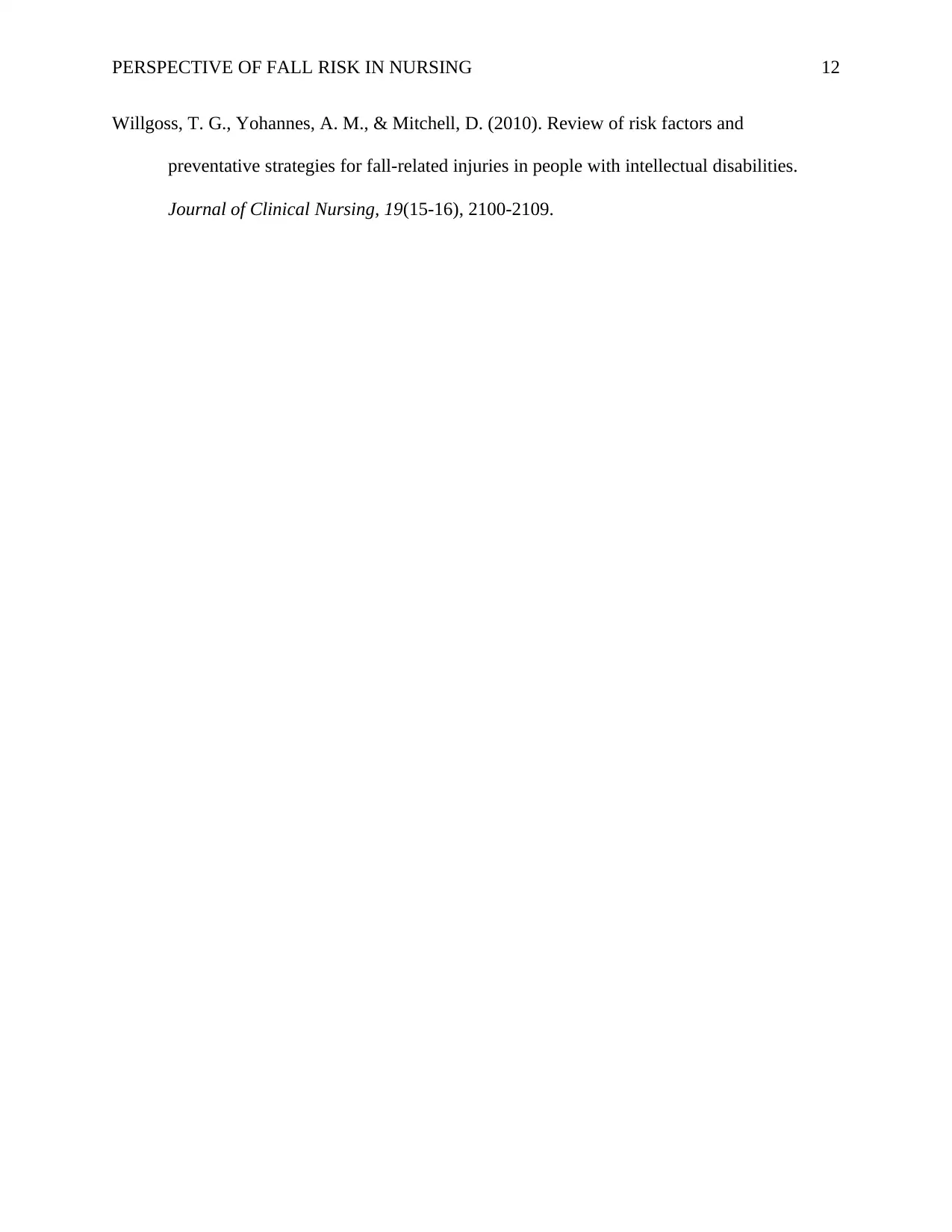
PERSPECTIVE OF FALL RISK IN NURSING 12
Willgoss, T. G., Yohannes, A. M., & Mitchell, D. (2010). Review of risk factors and
preventative strategies for fall-related injuries in people with intellectual disabilities.
Journal of Clinical Nursing, 19(15-16), 2100-2109.
Willgoss, T. G., Yohannes, A. M., & Mitchell, D. (2010). Review of risk factors and
preventative strategies for fall-related injuries in people with intellectual disabilities.
Journal of Clinical Nursing, 19(15-16), 2100-2109.
⊘ This is a preview!⊘
Do you want full access?
Subscribe today to unlock all pages.

Trusted by 1+ million students worldwide
1 out of 12
Related Documents
Your All-in-One AI-Powered Toolkit for Academic Success.
+13062052269
info@desklib.com
Available 24*7 on WhatsApp / Email
![[object Object]](/_next/static/media/star-bottom.7253800d.svg)
Unlock your academic potential
Copyright © 2020–2025 A2Z Services. All Rights Reserved. Developed and managed by ZUCOL.





